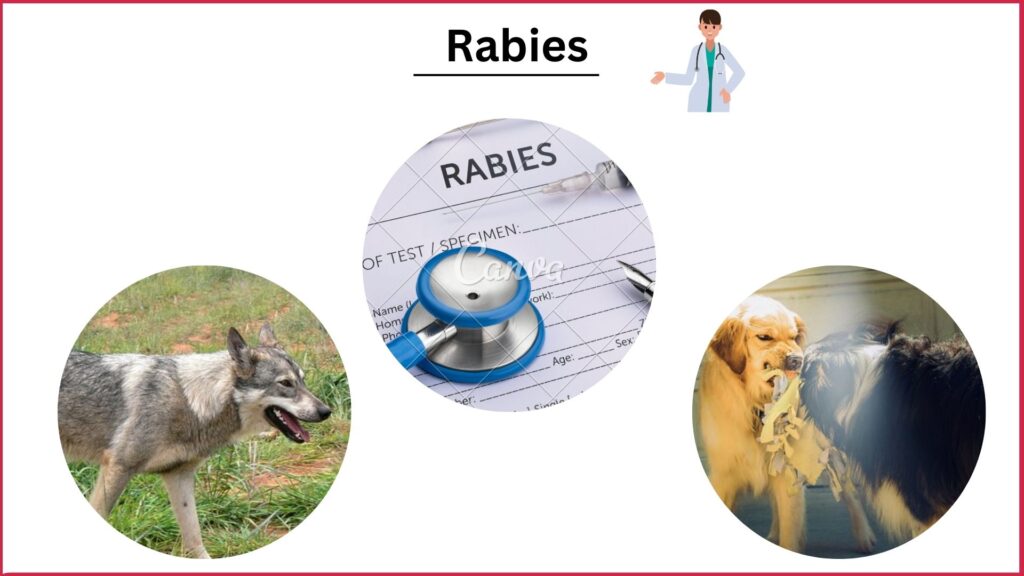Rabies : definition, vaccine, transmission & treatment
Rabies
We have described in article :
Definition of Rabies
Clinical feature of Rabies virus
Management of human Rabies virus
Laboratory diagnosis of rabies
Prevention of Rabies
Mode of transmission of rabies

Definition of rabies :
Define : An acute virus disease of the nervous system of mammals that is caused by a Rhabdovirus (species Rabies virus of the genus Lyssavirus) usually transmitted through the bite of a rabid animal and that is characterized typically by-
- Increased salivation
- Abnormal behavior
- Eventual paralysis (
- Death when untreated.
Definition of Rabies virus :
Define : Rabies virus is the species of the Rhabdoviridae that causes rabies in humans. The virus infects the cell in the brain, causing a fatal encephalomyelitis.
Properties of Rabies virus :
- RNA virus
- Single stranded RNA enclosed within a bullet shaped capsid.
- Lipoprotein envelope.
- Contains RNA dependent RNA polymerase.
- Killed by sunlight, heat or liquid solvent
- Replicate in cytoplasm
- If not treated. 100% mortality.
Main reservoirs of rabies virus :
- Dogs (99% cases in Bangladesh
- Wolf
- Mongoose
- Jackal
- Cat
- Hyena
- Fox
- Vampire bat.
Clinical features of rabies :
- Fever, anorexia, change in sensation in bite site.
- Confusion, lethargy. Salvation
- Painful throat muscle spasm on swallowing →Hydrophobia
- Serizure, paralysis, coma.
- Death (due to respiratory failure): Almost 100% fatality.
Management of human rabies :
Wound management :
- Cleaning of the wound.
- Chemical treatment by alcohol or tincture iodine.
- Suturing if needed
- Antibiotics and anti-tetanus measures
Post exposure prophylaxis: Passive :
Passive : Human rabies immunoglobulin.
Active : Human diploid cell vaccine –
- Dose-1ml (0, 3, 7, 14, 30 & 90 days).
- Slight risk-2ml × 7 days
- Moderate 5 ml x 14 days
- Great risk- 10 ml x 14 days
Laboratory diagnosis of rabies :
Principle : Diagnosis is based on the detection of viral antigen in CNS/SE fluorescence and negribodies in postmortem.
For human :
- Fluorescent- antibody staining of biopsy specimen.
- Isolation of virus from saliva, spinal fluid and brain tissue.
- Rise in titre of antibody
- Negribodies – in corneal scraping and brain tissue.
For animal :
- The specimen is brain tissue. The tests are :
- Fluorescent antibody to rabies virus
- Staining for negribodies.
- Cell culture
Preventive and control measures of rabies :
- Immunization of pet dogs and cats annually.
- Licensing of dogs
- Quarantine measures for entry of dogs in rabies free areas.
- Collection and destruction of stray dogs.
- Ten-days detention and observation of dogs and cats known to have bitten a person or showing suspicious signs of rabies.
- Unvaccinated dogs or cats bitten by known rabid animals should be destroyed.
- Immediate submission of intact head of animal that die of suspected rabies for laboratory examination.
- Pre exposure immunization of high-risk groups e.g. veterinarians, dog handlers and laboratory workers with HDCV given IM in 3 doses (1 ml each) on days 0, 7.21 or 28.
- Post-exposure measures :
- Local treatment of wound.
- Immunization.
Mode of transmission of rabies :
1) . Animal bites : Most of the human rabies results from the bitting of —
- Rabid dog.
- Also cat, monkey, jackal, horse & sheep etc. As a pre-requisite to transmission, the saliva of the biting animal must contain rabies virus at the time of bite.
2) Licks :
- Licks on abraded skin and mucosa.
- Injury with bone splinter or other object contaminated by the saliva of a rabid animal.
3) Aerosols : Aerosols of bat secretions containing rabies virus.
- Only in certain caves harbouring rabies infected bat.
- In the laboratory, aerosols created during homogenization of infected animal brains can infect lab workers.
4) Person to person –
- Child biting to parents
- Corneal and organ transplantation.
Peculiarities of rabies from other communicable diseases :
- It is the only communicable disease of man that is always fatal.
- Highly variable incubation period in man, commonly 1– 3 months following exposure but may vary from 7 days to many years. The incubation period depends on the site of the bite, severity of the bite, number of wounds, amount of virus injected, species of the biting animal, protection provided by the clothing and treatment undertaken, if any. In no other communicable disease incubation period is so variable and dependent on so many factors.
Street virus :
Street virus : The virus recovered from naturally occurring cases of rabies is called street virus. The virus is excreted in the saliva of affected animals. The virus as it occurs in nature is known as street virus.
- The virus can be also isolated from human cases.
- It is pathogenic to all mammals
- It can multiply in the neuronal and extra-neuronal tissue(muscles).
- It has a long variable incubation period (20-60 days) in days.
- It forms Negri bodies.
Fixed virus
Fixed virus : It is defined as one that has a short, fixed and shortened incubation period when collected after serial brain to brain passage of the natural virus into a suitable animal Serial brain-to-brain passage of the street virus in rabbits modifying the virus to form fixed virus.
- It can multiply in the neuronal tissue but not in extra neuronal tissue(muscle)
- Direct injection to brain produce encephalitis
- Does not form Negri bodies
- It is used to prepare rabies vaccine.
- It is non-pathogenic. It may be pathogenic, if rabies vaccine (prepared from fixed virus) is injected after inadequate inactivation.

I went over this internet site and I conceive you have a lot of great information, saved to my bookmarks (:.